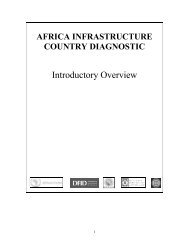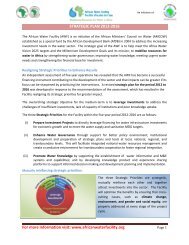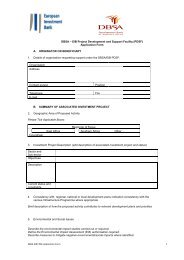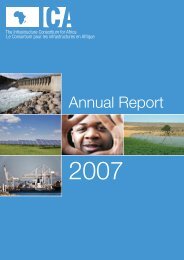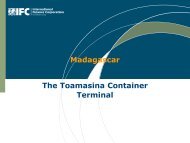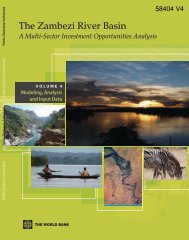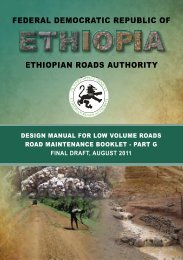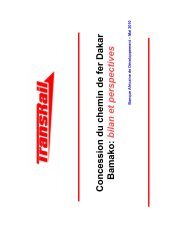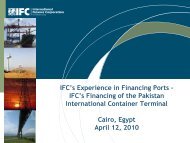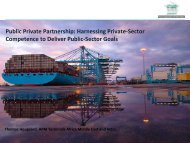challenges of eastern and southern africa ports / investment ...
challenges of eastern and southern africa ports / investment ...
challenges of eastern and southern africa ports / investment ...
You also want an ePaper? Increase the reach of your titles
YUMPU automatically turns print PDFs into web optimized ePapers that Google loves.
CHALLENGES OF EASTERN AND SOUTHERN<br />
AFRICA PORTS / INVESTMENT OPPORTUNITIES<br />
AND PRODUCTIVITY<br />
BY Jerome Ntibarekerwa<br />
Secretary General,<br />
PMAESA<br />
(Port Management Association <strong>of</strong> Eastern & Southern Africa)
OVERVIEW<br />
• Introduction<br />
• Traffic Trends in PMAESA Region<br />
• Factors driving traffic growth<br />
• Challenges facing Regional Shipping<br />
• Strategies to address <strong>challenges</strong><br />
• Investment Opportunities<br />
• Success Factors for attracting<br />
<strong>investment</strong>s<br />
• Conclusion
Introduction<br />
Who we are?<br />
Port Management Association <strong>of</strong> Eastern & Southern Africa<br />
(PMAESA) is a regional grouping <strong>of</strong> <strong>ports</strong> in the <strong>eastern</strong> <strong>and</strong><br />
<strong>southern</strong> Africa, established in 1973 under the auspices <strong>of</strong> the<br />
UNECA. Its membership is composed <strong>of</strong> state representatives <strong>and</strong><br />
private sector from:<br />
Port Authorities<br />
Maritime transport departments<br />
Port Operators<br />
Maritime regulators
Introduction ( Continued …)<br />
What we do<br />
Offer platform to exchange ideas <strong>and</strong> information where<br />
members can interface with one another in transport <strong>and</strong> trade<br />
facilitation;<br />
Assist port development by enhancing productivity <strong>and</strong> service<br />
delivery <strong>and</strong> trade facilitation;<br />
Establish linkages from <strong>ports</strong> to transport Corridors;<br />
Assist our <strong>ports</strong> /maritime members to implement IMO<br />
conventions;<br />
Establish <strong>and</strong> maintain relations with other development<br />
partners <strong>and</strong> transport authorities for the study <strong>of</strong> matters<br />
beneficial to members.
PMAESA member states<br />
Angola<br />
Burundi<br />
Djibouti<br />
Ethiopia<br />
Eritrea<br />
Kenya<br />
Madagascar<br />
Malawi<br />
Mauritius<br />
Mozambique<br />
Namibia<br />
Rw<strong>and</strong>a<br />
Seychelles<br />
South Africa<br />
Sudan<br />
Tanzania<br />
Zambia<br />
Zimbabwe
Port performance<br />
(DWT “000”)<br />
SELECTED PMAESA TOTAL PORT TRAFFIC (DWT "000)<br />
2005 2006 2007 2008 2009 ANNUAL %<br />
GROWTH<br />
DJIBOUTI 5,435 5,489 7,470 9,379 10,310 9.9%<br />
KENYA 13,281 14,419 15,962 16,415 19,062 16.1%<br />
MAURITIUS 5,602 5,686 7,040 7,420 8,162 10.0%<br />
REUNION 3,765 3,947 4,214 4,286 4,457 4.0%<br />
SOUTH AFRICA 173,555 179,984 183,353 185,079 182,735 -1.3%<br />
TANZANIA 6,864 7,291 7,427 7,421 8,103 9.2%<br />
NOTE: Data for Djibouti, Mauritius <strong>and</strong> Reunion is not yet available for 2009.<br />
Therefore an acceptable rate <strong>of</strong> projection has been applied for 2009
Container traffic<br />
SELECTED PMAESA PORTS CONTAINER TRAFFIC (TEUS)<br />
2005 2006 2007 2008 2009<br />
ANNUAL %<br />
GROWTH<br />
DURBAN<br />
CAPETOWN<br />
MOMBASA<br />
PORT ELIZABETH<br />
DAR ES SALAAM<br />
DJIBOUTI<br />
EAST LONDON<br />
RICHARD BAY<br />
1,899,065<br />
690,895<br />
436,671<br />
369,759<br />
287,948<br />
195,250<br />
49,338<br />
5,179<br />
2,198,600 2,479,232 2,642,165 2,395,084 -9.4%<br />
782,868 764,005 767,501 759,951 -1.0%<br />
479,355 585,367 615,733 618,816 0.5%<br />
392,813 422,846 423,885 309,018 -27.1%<br />
256,391 333,980 373,548 473,705 26.8%<br />
224,896 294,902 356,462 392,108 10.0%<br />
38,308 41,986 57,418 42,224 -26.5%<br />
4,191 4,021 9,350 6,273 -32.9%
Factors driving traffic<br />
growth in the PMAESA region<br />
External Factors:<br />
• Strong GDP expansion<br />
• Integration <strong>of</strong> regional economies with Asian suppliers<br />
• Political stability<br />
Internal factors:<br />
• Privatization <strong>of</strong> <strong>ports</strong> sector - increased <strong>investment</strong><br />
• Improved shipping links with Asia<br />
• Increased ship size <strong>and</strong> transshipment<br />
• Improved terminal productivity
Key Challenges in PMAESA Ports<br />
• Insufficient container storage space<br />
• Long container dwell time<br />
• Rapid increase in container traffic<br />
• Low performance <strong>of</strong> inl<strong>and</strong> modes <strong>of</strong><br />
transport especially the rail lines with very<br />
low availability <strong>of</strong> wagons <strong>and</strong> locomotives.<br />
• Acquiring more space for port activities
Key Challenges Cont’<br />
• Infrastructure development: Purchasing new<br />
equipments<br />
• The use <strong>of</strong> ICDs<br />
• Developing IT systems <strong>and</strong> free port activities<br />
• Restructuring the management model<br />
• Improving safety, security <strong>and</strong> environment<br />
protection to meet international st<strong>and</strong>ards
Strategies to address <strong>challenges</strong><br />
• More <strong>investment</strong> to increase container<br />
terminals capacity <strong>and</strong> Inl<strong>and</strong> Depot<br />
• Improve efficiency <strong>and</strong> productivity within the<br />
existing port infrastructure <strong>and</strong> equipment<br />
• Continue to involve private sector in port<br />
operations <strong>and</strong> concessioning which will<br />
improve port development
Investment Opportunities<br />
• Development <strong>of</strong> Free Zones activities<br />
• Private sector Participation in port<br />
development activities<br />
• Restructuring towards L<strong>and</strong>lord Port with<br />
Private sector participation<br />
• Improvement <strong>of</strong> operational practices by<br />
concession <strong>of</strong> commercial <strong>and</strong> operational<br />
activities.<br />
• Railway sector as the less expensive, safer<br />
<strong>and</strong> secure mode <strong>of</strong> transport than road<br />
haulage
Challenges with Growing Dem<strong>and</strong>:<br />
Key <strong>ports</strong> in the region<br />
Key <strong>ports</strong> in the Eastern <strong>and</strong> Southern<br />
Region:<br />
• Kenya Ports Authority<br />
• Tanzania Ports Authority<br />
• South Africa , Transet NPA<br />
• Djibouti port , DP World<br />
• Sudan port Cooperation
Challenges with<br />
Kenya Ports Authority<br />
• The rapid increase <strong>of</strong> traffic is likely to continue<br />
• The container Dwell time is yet to be reduced<br />
• The hinterl<strong>and</strong> rail connections remain inefficient<br />
• More dependence on road mode <strong>of</strong> transport with 3<br />
axle road rule constraint for hauliers<br />
• Long documentation procedures<br />
• Inadequate capacity to h<strong>and</strong>le the forecasted cargo<br />
volumes;
Challenges with Kenya<br />
Ports Authority (Cont)<br />
• The exploration <strong>of</strong> Oil in Lamu District<br />
• The Regional Integration expectations :<br />
EAC/COMESA Customs Union expected<br />
positive results<br />
• The Transport Sector Reforms : Concession<br />
<strong>of</strong> RVR, Rehabilitation <strong>of</strong> major roads links to<br />
other countries
Challenges with Djibouti Ports<br />
• The throughput in TEU has grown by 31% in 2007<br />
while the General Cargo grew by 44%<br />
• The stripping operations by Freight Forwarders<br />
remain very slow<br />
• The yard is occupied at 95%<br />
• There is a high level <strong>of</strong> stacking ( up to 5 highs)<br />
• The number <strong>of</strong> full <strong>and</strong> empty containers is very high<br />
• The port is facing many difficulties linked with<br />
Ethiopian bureaucracy as 85% <strong>of</strong> the total h<strong>and</strong>led<br />
cargo is for Ethiopia
Challenges with Tanzania<br />
Ports Authority<br />
• The insufficient container storage space<br />
• The long container dwell time (has reached<br />
25 days in Aug.2008)<br />
• The rapid increase <strong>of</strong> container traffic <strong>and</strong><br />
• The low performance <strong>of</strong> inl<strong>and</strong> modes <strong>of</strong><br />
transport especially the rail lines with very<br />
low availability <strong>of</strong> wagons <strong>and</strong> locomotives.
Challenges with Tanzania<br />
Ports Authority (Cont)<br />
• More <strong>investment</strong> to increase container<br />
terminals capacity <strong>and</strong> Inl<strong>and</strong> Depot<br />
• Improve efficiency <strong>and</strong> productivity within<br />
the existing port infrastructure <strong>and</strong><br />
equipment<br />
• Continue to involve private sector in port<br />
operations <strong>and</strong> concessioning which will<br />
improve port development
Challenges in South Africa<br />
(TRANSNET NPA)<br />
Responding to the opportunities presented by :<br />
1. Growth in global economic activity - increase inter/intra<br />
African trade<br />
• Link industrial <strong>and</strong> mining sector activity to markets<br />
• Alternate logistic & hub – South S trade<br />
• Regional economic integration – Transport corridor<br />
development<br />
• Intermodal harmonisation to improve regional supply<br />
chain <strong>and</strong> reduce logistics costs
Challenges with<br />
Sea Port Corporation – Sudan<br />
• To cope with technological advances in<br />
maritime industries<br />
• To face the political <strong>and</strong> economical<br />
<strong>challenges</strong> internally <strong>and</strong> externally:<br />
Requirements <strong>of</strong> WTO,COMESA agenda<br />
• Exploration <strong>of</strong> Sudanese Oil,<br />
• To h<strong>and</strong>le economic activities logistics after<br />
Peace Agreements in Sudan.
Key Success Factors for attracting<br />
<strong>investment</strong>s<br />
A real political will<br />
Good governance : Transparency in<br />
adjudication criteria <strong>and</strong> in decision<br />
making in case <strong>of</strong> concession <strong>and</strong> / or<br />
privatization process<br />
Move all “ Bottlenecks” relating to policy,<br />
regulatory, bureaucracy etc…<br />
Fiscal <strong>and</strong> non fiscal incentives
Proposed series <strong>of</strong> fiscal <strong>and</strong><br />
non fiscal incentives<br />
• A simplified legal framework<br />
• A range <strong>of</strong> tax <strong>and</strong> non tax incentives<br />
• Exemption <strong>of</strong> income taxes, customs duties<br />
• Free access <strong>and</strong> transfer <strong>of</strong> the foreign<br />
currencies<br />
• Repatriation <strong>of</strong> pr<strong>of</strong>its <strong>and</strong> dividends<br />
• Guarantee <strong>of</strong> property right<br />
• Dispute resolution by International Arbitration<br />
etc…
Conclusion<br />
Promotion <strong>of</strong> foreign Investment in<br />
PMAESA Region will require :<br />
1. A Real Political will ( flexibility in decision<br />
making)<br />
2. A Number <strong>of</strong> elements to guarantee<br />
Return on Investment (ROI)
Thank you for your attention<br />
Do You Have<br />
Any Questions?



